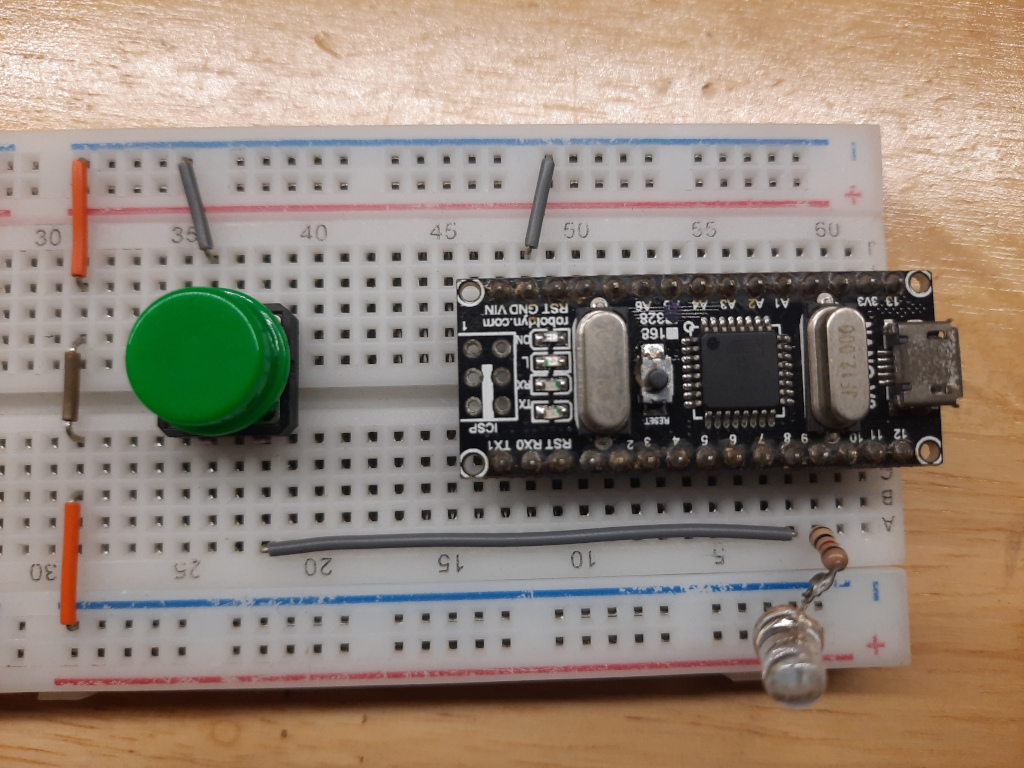Updated:
As an example for beginners, I needed an example program that does a simple thing, with very few standard functions of Arduino. Here is an example Arduino program; a simple kitchen timer.
The program uses just a few standard functions;
This article is a brief summary of one of my electronics classes on every weekends.
Requirements
The kitchen timer has a tactile switch, and an LED. Here is what the kitchen timer does. It should:
- Start the timer when the button is pressed
- Blink the LED at low frequency (1 Hz) until the timer reaches the defined time (
WAIT_TIME_SEC, 7 seconds). - Blink the LED at a high frequency when the timer reaches the defined time.
As an example for beginners, it also should:
- Use input and output
- Use a few standard functions (
digitalRead(),digitalWrite(), anddelay()) - Use a few commonly-available components
Materials
- Arduino Nano, or Arduino Uno
- Jumper wires
- An LED (any color) and a current limiting resistor (1K ohms should work with any LED)
- A tactile switch
- A breadboard
Schematic

Wiring

Connect a tactile switch to START_BUTTON_GPIO_NUM (D9) pin. Connect the other pin of the tactile switch to GND. As commented in the schematic, D9 is an input pin with the internal pull-up resistor enabled. That means, when the button is not pressed, the voltage is VCC, or +5V. When pressed, it’s 0V. Thanks to the internal pull-up resistor, the pin does not make short-circuit.
Connect an LED to LED_GPIO_NUM (D10) pin with a resistor. 1K resistor should work regardless of the color of the LED.
The program
The program does include some comments. Note that they are intended for my students.
#define
#define LED_GPIO_NUM (10)
#define START_BUTTON_GPIO_NUM (9)
#define WAIT_TIME_SEC (7)
#define WAIT_TIME_MS (WAIT_TIME_SEC * 1000)
#define DELAY_TIME_SEC (0.5)
#define DELAY_TIME_MS (DELAY_TIME_SEC * 1000)
#define defines a macro variable. This is not a C or C++ function, but a C++ preprocessor statement. These macro variables are replaced by the preprocessor at compile time. Examples:
#define SOME_TEXT "Some text here"
#define SOME_NUMBER (1)
Every time C preprocessor encounters SOME_TEXT or SOME_NUMBER, the macro variables are replaced with their values. When the value is a number, always enclose it with (), which prevents surprises. Without (), it works sometimes, and not always. An example:
#define TWO 1 + 1
This defines TWO as number 2. When you multiply it, the result is a surprise.
#define TWO 1 + 1
int i = TWO * 2:
// i is 3.
This is because of the precedence in the math. The actual code after preprocessing is:
int i = 1 + 1 * 2;
To define numbers, always enclose them with () to avoid this problem.
#define TWO (1 + 1)
int i = TWO * 2;
// i is 4.
Macro variables should have a unit at the end so that readers understand what it is not only from the name, but also the unit. WAIT_TIME_MS is clearer than WAIT_TIME because it is evident that the variable is time in seconds. _MS is often used to represent as milliseconds.
Global variables
unsigned long started_time_ms;
int led_state;
The program needs to remember two things; time when the timer has started and the state of the led. As these are referenced in functions, they need to be a global variable.
To obtain time, millis() is used. millis() returns a value in unsigned long, not int. To obtain voltage of GPIO pins, digitalRead() is used. It returns HIGH or LOW as int.
The setup function
void
setup()
{
pinMode(LED_GPIO_NUM, OUTPUT);
/* enable input on START_BUTTON_GPIO_NUM pin with a pullup resistor */
pinMode(START_BUTTON_GPIO_NUM, INPUT_PULLUP);
initializeLED();
waitForeverUntilButtonIsPressed();
resetTimer();
}
The setup() below does four things:
- configure
LED_GPIO_NUMpin as output - configure
START_BUTTON_GPIO_NUMpin as input with an internal pull-up resistor enabled - initialize the LED
- wait until the button switch is pressed
- reset the timer and start
Except INPUT_PULLUP, everything is straightforward. What is INPUT_PULLUP?
A pull-up resistor (and a pull-down resistor) is a resistor to keep a voltage at a certain level, usually, VCC. Here is three switches as input, without a resistor, with a pull-up resistor, and with a pull-down resistor.

The first one — without a resistor — is dangerous, and you should not use it because, when you push SW2, VCC and GND are connected, which is a short-circuit. There should be something that prevents the short-circuit. Pull-up resistor and pull-down resistor do that job.
The second one has a pull-up resistor, R2. When the switch, SW3, is open, the voltage at the GPIO is VCC (the resistor pulls up the voltage to VCC). When the switch is closed, the voltage is 0V.
The third one has a pull-down resistor, R3. When the switch, SW4, is open, the voltage at the GPIO is 0V (the resistor pulls down the voltage to GND). When the switch is closed, the voltage is VCC.
The value of pull-up, and pull-down resistors is usually 10K ohm or so. The value affects the current when the switch is opened or closed. When VCC is 5V, the current is $ I = { V \over R } = { 5 \over 10,000 } = 0.5 (mA)$.
Some GPIO pins have internal pull-up resistors built-in. If you enable one with pinMode(pin, INPUT_PULLUP), it is not necessary to add an external pull-up resistor to the switch because the pin is internally connected to VCC through a pull-up resistor.
the loop() function
void
loop() {
delay(DELAY_TIME_MS);
/* millis() returns the current time since the micro computer started.
* the return value is an unsigned int.
*/
if (started_time_ms + WAIT_TIME_MS <= millis()) {
notifyUser();
waitForeverUntilButtonIsPressed();
initializeLED();
resetTimer();
} else {
toggleLED();
}
}
In the loop(), it has a delay() and a if-else. started_time_ms holds the time in millisecond when the timer has started. WAIT_TIME_MS — a macro variable — is 7000. started_time_ms + WAIT_TIME_MS is the time when the timer should notify the user. Otherwise, toggle the LED, i.e. if the lED is on, turn it off and vice versa.
initializeLED()
void
initializeLED()
{
led_state = LOW;
digitalWrite(LED_GPIO_NUM, led_state);
}
The function sets led_state to LOW, the initial state. Nothing new here.
isButtonPressed()
bool
isButtonPressed()
{
/*
if (digitalRead(START_BUTTON_GPIO_NUM) == LOW) {
return true;
} else {
return false;
}
*/
/* same as the above code */
return digitalRead(START_BUTTON_GPIO_NUM) == LOW;
}
The function returns true or false. If START_BUTTON_GPIO_NUM is LOW, return true (the button is pressed). Otherwise, false.
toggleLED()
void
toggleLED()
{
/*
if (led_state == HIGH) {
led_state = LOW;
} else {
led_state = HIGH;
}
*/
/* same as the above code. it's called a "ternary operator".
* x = condition ? condition is true : condition is false
*/
led_state = led_state == HIGH ? LOW : HIGH;
digitalWrite(LED_GPIO_NUM, led_state);
}
The function toggle the LED. Instead of if-else, a ternary operator is used as a short-hand.
Further improvements
This kitchen timer is so simple and it has a room for improvements.
The kitchen timer only blinks the LED. When making food, you do not want to watch the timer. Instead, the timer should beep, optionally blink the LED.
The timer is a fixed timer, namely 7 seconds. This is not very practical. Users should be able to set arbitrary time period, such as 1 minutes, 7 minutes and 30 seconds.
The only feedback is the LED. Users should be able to know the remaining time. The timer should show the remaining time in a display in real time.
When the button is not pressed for a while and the timer has NOT started, say 5 minutes, it should sleep to save power.
Final words
This post is a summary of my class. Of course, I teach more than what is described here, usually in two 2-hours classes, depending on the skill level of students. If you can understand everything by reading this post, you don’t have to attend the class. If you don’t, join the class where I will explain and answers all your questions.
Happy hacking!
